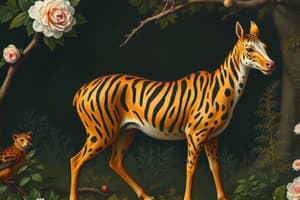Podcast
Questions and Answers
Who is considered the 'Father of Zoology'?
Who is considered the 'Father of Zoology'?
- John Ray
- Gregor Mendel
- Charles Darwin
- Aristotle (correct)
How did Aristotle categorize animals based on their blood?
How did Aristotle categorize animals based on their blood?
- By their color
- By their diet
- By their habitat
- By the presence or absence of red blood (correct)
According to Aristotle, what categorization is used for animals living on land?
According to Aristotle, what categorization is used for animals living on land?
- Terrestrial (correct)
- Amphibious
- Aquatic
- Aerial
Which biologist was the first to use structural similarities as the basis of classification?
Which biologist was the first to use structural similarities as the basis of classification?
How did John Ray define a 'species'?
How did John Ray define a 'species'?
What principle did natural classification adopt for grouping animals?
What principle did natural classification adopt for grouping animals?
What is the term used to describe a group of animals with common characteristics that is smaller than a phylum but larger than an order?
What is the term used to describe a group of animals with common characteristics that is smaller than a phylum but larger than an order?
How are phyla defined within the animal kingdom?
How are phyla defined within the animal kingdom?
What is the significance of Linnaeus' classification system on the study of animals?
What is the significance of Linnaeus' classification system on the study of animals?
How do orders differ from classes in taxonomic classification?
How do orders differ from classes in taxonomic classification?
What is the correct hierarchical order from largest to smallest in the Linnaeus classification system?
What is the correct hierarchical order from largest to smallest in the Linnaeus classification system?
How do genera differ from families in taxonomic classification?
How do genera differ from families in taxonomic classification?
Flashcards are hidden until you start studying
Study Notes
Aristotle's Classification
- Divided animals into two groups: Enaima (with red blood) and Anaima (without red blood)
- Classified animals based on environment: aquatic, terrestrial, and aerial
- Classified animals based on diet: carnivorous and herbivorous
- Classified animals based on reproduction: oviparous and viviparous
Natural Classification
- Groups animals based on structural similarities and evolutionary relationships
- Not based on superficial resemblance
John Ray's Contributions
- First systematist to use structural similarity for classification
- Defined 'species' as the largest group of organisms capable of reproducing and producing a fertile offspring
Linnaeus' Classification
- Published in "Systema Naturae"
- Made the study of animals convenient and indicated true evolutionary relationships
- Helpful in identifying animals
- Stimulated discovery and naming of new species
Modern Classification
- Expanded form of Linnaeus' classification
- Divided into phyla, classes, orders, families, genera, and species
Taxonomic Divisions
- Phylum: an assemblage of animals with common characteristics
- Class: a smaller group with characteristics of the phylum and more specific structural characteristics
- Order: a smaller group with characteristics of the phylum and class, and some common characteristics peculiar to the order
- Family: a smaller group within an order
- Genus: a smaller group within a family
- Species: a group of individuals with characteristics of the larger groups and its own identifying characteristics
Studying That Suits You
Use AI to generate personalized quizzes and flashcards to suit your learning preferences.




